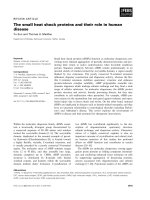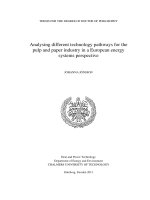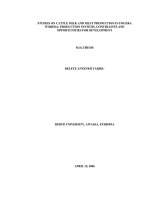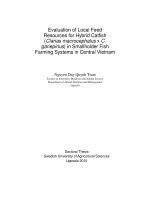PEMFC heat recovery for preheating inlet air in standalone solar hydrogen systems for remote telecommunication applications (tt)
Bạn đang xem bản rút gọn của tài liệu. Xem và tải ngay bản đầy đủ của tài liệu tại đây (203.43 KB, 12 trang )
PEMFC HEAT RECOVERY FOR PREHEATING INLET AIR IN
STANDALONE SOLAR-HYDROGEN SYSTEMS FOR REMOTE
TELECOMMUNICATION APPLICATIONS
A thesis submitted in fulfilment of the requirements for the degree of
Master (by Course work)
Student name:
HUY QUOC NGUYEN
Student number:
3463748
Supervisor:
Dr. Bahman Shabani
SCHOOL OF AEROSPACE, MECHANICAL & MANUFACTURING ENGINEERING
RMIT UNIVERSITY
Melbourne, 2015
i
To my wife, Huong Thao and my son, Gia Hung
ii
ACKNOWLEGMENT
First and foremost, I would like to express my sincere gratitude to my supervisor, Dr.
Bahman Shabani, for his patience, motivation, enthusiasm and support of my study and
research. I appreciate his vast knowledge and skills in sustainable energy areas, and his
assistance in writing papers and valuable comments.
My sincere thanks go to Asma Mohamed Aris, a PhD student in RMIT, for her advice,
support and sharing knowledge about solar-hydrogen system with me.
I want to express my gratitude to my parents for their motivation, encouragement and
support me.
I would also express my loving appreciation to my wife, Huong Thao for her
unconditional support, patience, understanding, and self-abnegation during my study.
iii
DECLARATION
I, Huy Quoc Nguyen, hereby submit the thesis entitled “PEMFC Heat Recovery for
Preheating Inlet Air in Standalone Solar-Hydrogen Systems for Telecommunication
Applications” in fulfilment of the requirements for the degree of Master degree by Course
work, and certify that except where due acknowledgement has been made, the work is
that of the author alone; the work has not been submitted previously, in whole or in part,
to qualify for any other academic award, and the content of the thesis is the result of work
that has been carried out since the official commencement date of the approved research
program.
Melbourne, Nov 2015
Huy Quoc Nguyen
iv
TABLE OF CONTENT
ACKNOWLEGMENT....................................................................................................iii
DECLARATION ...........................................................................................................iv
TABLE OF CONTENT ..................................................................................................v
LIST OF FIGURES ......................................................................................................vii
LIST OF TABLES ........................................................................................................ix
EXECUTIVE SUMMARY ...............................................................................................x
1.
Introduction .........................................................................................................1
1.1.
Background ..................................................................................................1
1.2.
Aim and objectives ......................................................................................3
1.3.
Research questions .....................................................................................4
1.4.
Methodologies ..............................................................................................5
1.5.
Scope ............................................................................................................5
1.6.
Hypotheses ...................................................................................................6
1.7.
Structure of the report .................................................................................6
2.
Literature review .................................................................................................8
2.1.
Issues of PEMFC’s operation in extreme cold environment ....................8
2.1.1. Impacts on the components of fuel cell ..........................................................8
2.1.2. Cold start issues...........................................................................................11
2.1.3. Issues of operating process .........................................................................12
2.2.
PEMFC Thermal Management Opportunities in Cold Climate Conditions
14
2.3.
An Exergy Analysis Approach ..................................................................17
2.4.
Solar-Hydrogen Systems for Telecom Applications ...............................18
3.
Exergy analysis for Theoretical Modeling ......................................................20
3.1.
Structure of Theoretical Modeling ............................................................20
3.2.
Overall Approach .......................................................................................21
3.3.
Exergy Mathematical Modeling in MATLAB .............................................23
3.3.1. Mathematical modeling ................................................................................23
3.3.2. Model Validation ...........................................................................................32
3.4.
A Case Study ..............................................................................................34
3.4.1. Description of the Case ................................................................................34
3.4.2. Results and Discussion ................................................................................38
1)
Effects of Heat Exchanger Effectiveness and Ambient Temperature ...........38
2)
Exergetic Efficiencies of PEMFC-HR and PEMFC-EH arrangements ..........41
3)
Exergetic Efficiency of a PEMFC in the Context of Telecommunication
Application ................................................................................................................44
4.
experimentally setting up pemfc with heat recovery for preheating inlet air
48
4.1.
Introduction ................................................................................................48
v
4.2.
Experimental setup ....................................................................................49
4.2.1. Description of overall system .......................................................................49
4.2.2. Hydrogen line ...............................................................................................50
1)
Properties of hydrogen .................................................................................50
2)
Measurement equipment..............................................................................50
4.2.3. Fuel cell ........................................................................................................51
1)
General information about the fuel cell stack ...............................................51
2)
Blowers ........................................................................................................53
3)
Air flow rates ................................................................................................53
4.2.4. Air line ..........................................................................................................54
1)
Overall plan ..................................................................................................54
2)
Manifolds ......................................................................................................55
3)
Heat exchanger ............................................................................................55
4)
Additional blower ..........................................................................................56
5)
Vortex Tube..................................................................................................57
6)
Measurements .............................................................................................58
7)
Tubing, Valves and connectors ....................................................................58
8)
Climate chamber ..........................................................................................59
9)
Insulation ......................................................................................................59
4.2.5. Electronic load..............................................................................................60
4.3.
Planning for future work ............................................................................60
5.
Conclusion ........................................................................................................62
1)
A reference environment model (Dincer & Rosen 2012) ..............................70
2)
Partial pressure and molar fraction of substances in the air (Dincer & Rosen
2012) 70
3)
Standard chemical exergy value of substance of the air at T 0 and P0 (Dincer
& Rosen 2012) ..........................................................................................................70
1)
Technical Specification ................................................................................71
2)
Performance Characteristics ........................................................................71
1)
Hydrogen Pressure Gauge...........................................................................74
2)
Hydrogen mass flow rate..............................................................................74
3)
K type thermocouple ....................................................................................75
4)
Data Taker DT80 ..........................................................................................75
5)
Vortex flow meter .........................................................................................75
vi
LIST OF FIGURES
Figure 1. Sankey diagram show energy flow of a PEMFC with heat recovery system ..2
Figure 2: Effects of ice formation on the membrane (Yan et al. 2006); (a) – fresh
PEM; (b) – Membrane after operate at 25 °C; (c) – Membrane after operate at -15 °C; (d)
– damage at pinhole when operate at -15 °C .....................................................................9
Figure 3: (a) Effect of thermal cycles on pore size of GDL; (b) Effect of thermal cycles
on the performance curve of fuel cell (Cho et al. 2003) ...................................................10
Figure 4: (a) Performance curves of a fuel cell as a function of temperature; (b)
Temperature of the cathode cell operation at various ambient temperatures (Yan et al.
2006)................................................................................................................................14
Figure 5: PEMFC combined heat and power schematic (Briguglio et al. 2011) ..........16
Figure 6: Schematic of a hybrid solar-hydrogen (hybridized with a battery system)
used as power supply system for remote telecommunication applications ......................19
Figure 7: Schematic of a PEMFC, with heat recovery arrangement for preheating inlet
air (PEMFC-HR), to be operated under extreme cold climate condition ..........................20
Figure 8: TRNSYS modelling arrangement of a hybrid solar-hydrogen/battery system
.........................................................................................................................................22
Figure 9: Schematic exergy balance diagram of a PEMFC-HR system; ࡱࡴǡ ,
ࡱࢇ࢘ǡ and ࡱࢉࢇ࢚ǡ are inlet exergy transfer of hydrogen, air and coolant air
respectively; ࡱࡴǡ ࢛࢚, ࡱࡴࡻǡ ࢛࢚, ࡱࢇ࢘ǡ ࢛࢚ and ࡱࢉࢇ࢚ǡ ࢛࢚ are outlet exergy of
hydrogen, product water, air and coolant air; ࢃࡱࡴ and ࢃࡲ are exergy of electric heater
and electrical output power ..............................................................................................24
Figure 10: A comparison between the cooling loads of a 500 W PEMFC obtained from
the model and those measured experimentally (Shabani & Andrews 2011) at 60-65 °C of
operating temperature......................................................................................................33
Figure 11: (a) Daily load profile of a typical BS site in Eureka, Canada (Bruni et al.
2014); (b) Annual temperature and horizontal solar radiation profiles of Eureka, Canada
.........................................................................................................................................34
Figure 12: PEMFC load profile obtained from TRNSYS simulation for the case study
described in section 3.4.2.3 .............................................................................................36
Figure 13: The characteristic curves of 2 kW PEMFC (H-2000) manufactured by
Horizon Fuel Cell Technologies (Horizon Fuel Cell Technologies 2013) .........................37
vii
Figure 14: The effect of heat exchanger effectiveness on the fuel cell (with heat
recovery to preheat the inlet air) inlet air temperature at various ambient temperatures;
the fuel cell operating temperature was assumed to be 65 °C .........................................39
Figure 15: Exergy destruction of main components of a 2-kW PEMFC-HR................40
Figure 16: Exergetic efficiency of the 2 kW PEMFC-HR suggested by the model at
various ambient temperatures, and 65 °C fuel cell operating temperatures ....................41
Figure 17: Variations of exergetic efficiency of PEMFC-HR and PEMFC-EH with
ambient temperature at operating temperature of 65 °C and 2 kW operating point based
on different desired inlet air temperature at cathode (ࢀࢉࢇሻ: 5 °C, 15 °C and 25 °C .........43
Figure 18: Exergetic efficiency of PEMFC-HR and PEMFC-EH arrangements over a
range of operating power at constant ambient and operating temperature (- 40 °C and 65
°C, respectively) based on the 5 °C required inlet air temperature at the cathode...........44
Figure 19: Exergetic efficiency of PEMFC-HR and PEMFC-EH based on the fuel cell
load and ambient temperature over a year period ...........................................................45
Figure 20: Percentage improvement between PEMFC-HR and PEMFC-EH systems.
The desired inlet air temperatures at cathode: 5 °C, 15 °C and 25 °C .............................46
Figure 21: Energy saving by using PEMFC-HR replaced for PEMFC-EH over a year
period; desired inlet air temperature at cathode: 5 °C, 15 °C and 25 °C .........................47
Figure 22: General schematic diagram of experiment rigs .........................................49
Figure 23: The 300 W PEMFC used for experimental setup .......................................52
Figure 24: The fuel cell controller ................................................................................52
Figure 25: Statistic – pressure characteristics of the 300 W PEMFC blowers ............53
Figure 26: Schematic of supplied air line ....................................................................54
Figure 27: Plate and Fin heat exchanger customized for experiment .........................56
Figure 28: Rule 3” Inline Bilge bower and its characteristic curve ..............................56
Figure 29: Vortex tube for cold air supply (EXAIR, 2014) ...........................................57
Figure 30: Kikusui PLZ1004W electronic load ............................................................60
viii
LIST OF TABLES
Table 1: Description of the components used in TRNSYS modelling .........................22
Table 2: Cost and economic assumptions for HOMER input (Shabani & Andrews
2015b)..............................................................................................................................35
Table 3: Optimal sizing of the solar-hydrogen/battery system for the case study and
fed into the TRNSYS model .............................................................................................35
Table 4: Operating condition of PEMFC-HR system ...................................................37
Table 5: Air flow rates of 300 W PEMFC at different power and air stoichiometry ......54
Table 6: Velocity of air at each pipe diameters ...........................................................59
ix
EXECUTIVE SUMMARY
Water and thermal management in the polymer exchange membrane (PEM) fuel cell is
considered as technical challenges not only in normal condition but also in sub-freezing
temperature. The present of water in pore of fuel PEMFC components like membrane
assembly (MEA), catalyst layer (CL) and gas diffusion layer (GDL) may freeze once the
cell temperature reduces to below the freezing point. Unbalance stress due to ice
formation within the cell may cause severe physical damage for components that results
in impact on durability and performance degradation of the fuel cell. An overview of the
effects of water phase change on the performance of the cell when it operates in subfreezing environment was presented. In addition, mitigation strategies for rapid up and
preventing fuel cell performance degradation is summarized. It is found from the literature
review that mitigation strategies only focus on integration an additional heat source for
warming the cell before the start. Furthermore, the higher inlet reactants temperature can
lead to the higher performance of fuel cell.
Using PEMFC for base stations (BSs) back-up power for remote telecommunication
application has been taken into consideration. However, in cold regions like Canada,
Alaska the PEMFC in the system is often experiencing extreme cold temperature
conditions (-50 °C of peak temperature during winter) that can lead to significant
performance degradation. In this case, an electric heater is normally used to preheat the
inlet air fed into the fuel cell for maintaining stable operation as well as mitigation
performance degradation of fuel cell. However, this strategy requires an additional
energy resulting in decrease in overall efficiency of system. At steady operating condition
about half of energy content of hydrogen reacted inside the fuel cell is converted to heat.
x
In this study, a theoretical model of a PEM fuel cell with heat recovery system that is
used to recover the generated heat from the cell stack for preheating the inlet air used in
the extreme cold environment was proposed. A mathematical model of the PEMFC with
heat recovery system was generated in MATLAB to dynamically simulate the
performance of the system. The model was then used to conduct an exergy analysis for
a case study of a 2 kW PEMFC to meet the load demand of a telecom base station in
Eureka, Canada where usually extreme cold climate condition are experienced. The
HOMER and TRNSYS are used to obtain the load profile of the PEMFC system over a
year operation of the case study. This is because, the yearly load profile is a key input
into the MATLAB model to conduct the exergy analysis on both PEMFC heat recovery
system and PEMFC with external heat system.
The results showed that the exergy destruction of the fuel cell stack is dominant in the
PEMFC-HR system, so by reducing the irreversibilities, the efficiency of the system can
be improved quite considerably. It was also found that the exergetic efficiency of the
PEMFC-HR system is not greatly affected (only about ~ 0.5%) by the ambient
temperature (over the range of -50°C to 30 °C). This analysis also suggested that
performing fuel cell heat recovery at higher power operating point can lead to better
improvement in the exergetic efficiency of the system as compared to the improvements
that can be achieved at lower power operating points (~40% improvement at maximum
power point compared to 25% at 100 W power point shown in section 3.4.2.3). This is
consistent with the fact that more heat is generated at operating points closer to fuel cell
rated power that is normally wasted if the fuel cell heat is not recovered for this purpose.
xi
According to the results of the case study, using the PEMFC-HR system for preheating
the inlet air is more effective, in terms of improving the exergy efficiency, at higher power
outputs, lower ambient temperatures, and higher desired inlet air temperatures. It was
also found that through the recovery and deployment of fuel cell’s generated heat, the
energy that is normally consumed (i.e. the parasitic energy) by using an external electric
heater, can be fully avoided if the heat exchanger used for this heat recover is of high
effectiveness (i.e. above 65%). By the account of the results of this case study,
implementing fuel cell heat recovery can lead to saving 1500 kWh to 3700 kWh (over the
5 – 25 °C range of set inlet air temperature) of energy. These savings are equivalent to
about 30-72% of the total yearly energy generated by the fuel cell stack.
An experimental system of PEMFC heat recovery working in simulated extreme cold
climate was designed and planned for future work. The main purpose of this
experimental study is to investigate experimentally the impacts of the heat recovery
system for preheating inlet air in such climate on the performance of the fuel cell.
xii









